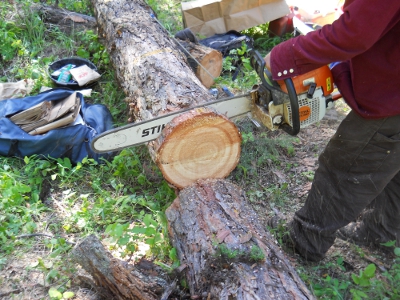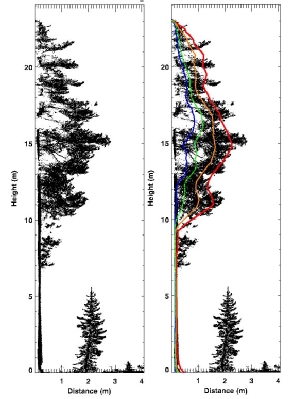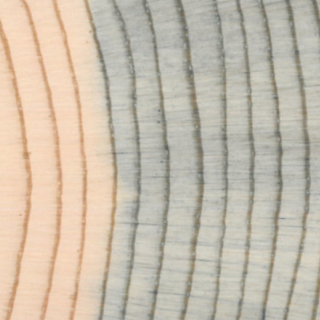Conifer Biomass
Assessment and Development of Tree Biomass Equations for the Major Commercial Species of the Inland Northwest
Background & Objectives
Across the Inland Northwest, there is increasing interest in the harvest of traditionally non-merchantable woody biomass and in the quantification of tree biomass/carbon stocks and crown fuels. Yet since Brown’s (1978; INT-RP-197) early development of crown weight equations, there have been no integrated analyses of the bias or accuracy of existing tree biomass estimators for the important conifer species of the region. Furthermore, from a crown fuels perspective both the abundance and vertical distribution of crown biomass is important, but there has been little research directed toward the quantification of conifer crown shape or density.

The primary goals of this study are 1) to evaluate and, as necessary, improve aboveground tree biomass equations for the major commercial species of the Inland Northwest and 2) quantify the vertical distribution of biomass from base to tip. The biomass components of central interest include stemwood, stembark, branchwood, and foliage. Secondary study objectives include the development of efficient crown biomass sampling strategies, the assessment of variation in stemwood density within and across trees, and the utility of terrestrial laser scanning in characterizing crown profiles.
Scope & Design
The study was initiated in 2009 with destructive sampling of Douglas-fir, ponderosa pine, lodgepole pine, and western larch across public and private lands in the Inland Northwest. Stem biomass components were assessed on sample trees from taper measurements and wood density; crown biomass was divided into foliage, live branch (3 size classes), and dead branch components and assessed using randomized branch sampling.
With funding from the Joint Fire Sciences Program (JFSP-10-1-02-13), in 2010 the study was broadened to include grand fir, subalpine fir, and Engelmann spruce. Field sampling intensified and was coupled with terrestrial laser scanning of tree crowns. Ground based laser scanning is ideal for measuring vertical variations in crown fuels as it permits direct estimations of both the horizontal extent of the crown and the opacity of the crown over the full height of the tree (see image below).
Through 2012, 279 trees have been destructively sampled from eastern Washington, northern Idaho, and western Montana, while 153 crowns have been scanned using terrestrial LiDAR.
Timeline
Field sampling will be complete by the end of 2012; laboratory processing will contine into spring 2013.
Analysis and reporting will be completed in fall 2013, when work will begin on integrating the biomass results into commercial and public growth simulators.
Final results will be presented at the INGY Technical Meeting in March 2014; preliminary and final results will also appear in peer-reviewed publications.
Reports & Presentations
Affleck, D.L.R., C. Keyes, & J.G. Goodburn (in press) Conifer Crown Fuel Modeling: Current Limits and Undeveloped Potential for Improvement. To appear in Western Journal of Applied Forestry.
Affleck, D.L.R. & B. Turnquist (2012) Assessing the Accuracy of Crown Biomass Equations in the Inland Northwest. In McWilliams &F.A. Roesch (eds.) Monitoring Across Borders: 2010 Joint Meeting of the Forest Inventory and Analysis

(FIA) Symposium and the Southern Mensurationists. GTR-SRS-157. Asheville, NC: USDA Forest Service, Southern Research Station, pp. 247-254
Ferrarese, J. & E. Rowell (2012) Species-Specific Crown Profiles Models from Terrestrial Laser Scanning. Inland Northwest Growth & Yield Cooperative Technical Meeting, 6-7 March 2012.
Ferrarese, J., E. Rowell, & C. Seielstad (2012) Modeling the Geometric Space of Douglas-fir Tree Crowns in the Northern Rocky Mountains, USA for Fire Behavior Simulation. Poster presented at Silvalaser 2012, 12th Internation Conference on LiDAR Applications for Assessting Forest Ecosystems, Vancouver, BC, 16-19 September 2012.
Turnquist, B.R. (2012) Assessment of Prediction Bias in Crown Biomass Equations for Important Conifer Species of the Inland Northwest. MSc Thesis, University of Montana, Missoula, MT.
Turnquist, B.R. (2012) Systematic Error Trends of Existing Crown Biomass Equations for the Major Commercial Conifers of the Inland Northwest. Inland Northwest Growth & Yield Cooperative Technical Meeting, 6-7 March 2012.
Affleck, D.L.R. (2011) Evaluating Crown Biomass Equations for the Inland Northwest USA. Western Mensurationists’ Meeting, Banff, AB, 19-21 June 2007.
Affleck, D.L.R. (2011) Trends in Crown Biomass and Crown Biomass Equation Accuracy Across the Inland Northwest. Inland Northwest Growth & Yield Cooperative Technical Meeting, 4-7 March 2011.
Schlecht, R.M. (2011) Application of Randomized Branch Sampling to Conifer Trees: Estimating Crown Biomass. MSc Thesis, University of Montana, Missoula, MT.
Seielstad, C., C. Stonesifer, E. Rowell, & L. Queen (2011) Deriving Fuel Mass by Size class in Douglas-fir (Pseudotsuga menziesii) Using Terrestrial Laser Scanning. Remote Sensing 3:1691-1709.
Stonesifer, C. (2011) Terrestrial Laser Scanning of Tree Biomass. Inland Northwest Growth & Yield Cooperative Technical Meeting, 4-7 March 2011.
Affleck, D.L.R. & B.R. Turnquist (2010) Revisiting Tree Biomass Equations for the Inland Northwest. Inland Northwest Growth & Yield Cooperative Technical Meeting, 4-7 March 2010.
Seielstad, C., C. Stonesifer, E. Rowell, & L.P. Queen (2010) Deriving Conifer Fuel Mass for Crown Modeling Using Terrestrial Laser Scanning. Paper and poster presented at the International Association of Wildland Fire 3rd Fire Behavior and Fuels Conference, Spokane, WA, 25-29 October 2010.
Data
Available upon request.
Figure: Terrestrial laser scan of a lodgepole pine (Pinus contorta) near Granite Pass, Idaho, with data normalized to ground height and distance from tree bole (10th, 30th, 50th, and 90th percentile distances from bole shown in right panel; blue, green, orange, red, respectively).
